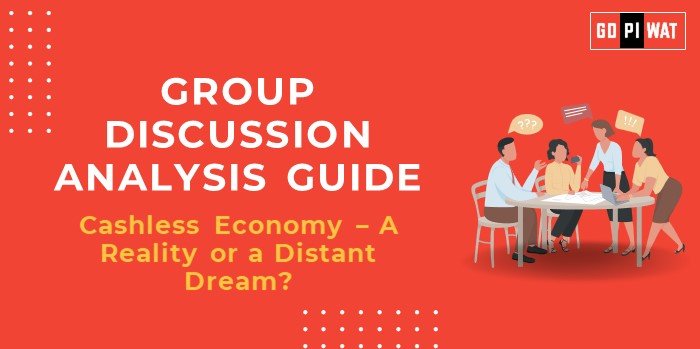📋 Group Discussion Analysis Guide: Cashless Economy – A Reality or a Distant Dream?
🌐 Introduction to Cashless Economy
The shift toward a cashless economy has gained momentum globally, with governments aiming for improved transaction efficiency, transparency, and enhanced security. For India, the journey toward a cashless economy is driven by initiatives like Digital India, which promote digital payments and financial inclusion. However, significant challenges remain, especially concerning the digital divide and cybersecurity.
📊 Quick Facts and Key Statistics
- 📈 Digital Payment Transaction Volume: Total digital payment transactions in India surged to 18,737 crore in FY 2023-24 from 2,071 crore in FY 2017-18, with a Compound Annual Growth Rate (CAGR) of 44%. The value of these transactions reached ₹3,659 lakh crore in FY 2023-24, up from ₹1,962 lakh crore in FY 2017-18.
- 💳 UPI Transaction Volume:
- Annual Total: In 2023 alone, India recorded over 117.68 billion UPI transactions, valued at approximately ₹182.84 trillion (USD 2.2 trillion).
- Growth Over Five Years: UPI transactions grew from 92 crore in FY 2017-18 to 13,116 crore in FY 2023-24, with a remarkable CAGR of 129%. The transaction value increased from ₹1 lakh crore to ₹200 lakh crore at a CAGR of 138%.
- International Reach: UPI now facilitates live transactions in seven countries, including the UAE, Singapore, Bhutan, Nepal, Sri Lanka, France, and Mauritius.
- 📈 Growth Rate: UPI usage in India has surged by around 60% year-over-year, establishing it as one of the fastest-growing digital payment systems globally.
- 📱 Mobile Payment Adoption: By 2025, approximately 750 million users are expected to adopt digital payments, with major platforms like PhonePe, Google Pay, and Paytm leading this growth.
- 🏞️ Rural Penetration: Initiatives like UPI for feature phones have expanded digital access, potentially connecting an additional 400 million rural users.
- 💸 IMPS (Immediate Payment Service): IMPS transactions also grew significantly, with 498.79 million transactions recorded in December 2023 alone, valued at ₹5.7 trillion.
🤝 Stakeholders and Their Roles
- 🏛️ Government: Enacts policies and infrastructure support for digital payments, as seen in initiatives like Digital India and UPI.
- 🏦 Financial Institutions: Facilitate secure and convenient digital transaction platforms.
- 💻 Technology Companies: Innovate solutions for cashless payments (e.g., Paytm, Google Pay).
- 👥 Consumers: Drive adoption and demand for digital payment platforms, especially among younger users.
- 🛡️ Cybersecurity Agencies: Implement regulations to protect against digital payment fraud and security breaches.
🏆 Achievements and ⚠️ Challenges
🏅 Achievements:
- High UPI Adoption: With over 117 billion transactions, UPI has become a widely accepted mode of payment.
- Mobile Payment Growth: Digital payments are set to reach around 750 million users by 2025, enabling widespread adoption.
- Financial Inclusion in Rural Areas: UPI for feature phones broadens accessibility, benefiting up to 400 million rural users.
⚠️ Challenges:
- Digital Divide: Only about 20% of rural households have internet access, limiting cashless transition in these areas.
- Cybersecurity Threats: Rising cyber risks as digital payment usage grows.
- User Resistance: Cash dependency remains strong among certain population segments, particularly in rural and older demographics.
🌍 Global Comparisons
- 🇸🇪 Sweden: Nearly 98% of payments are digital, leading the cashless transformation globally.
- 🇨🇳 China: Widespread adoption of mobile payments through platforms like WeChat Pay has nearly eliminated cash dependency.
📚 Case Studies
- Kerala: Achieved high digital literacy and digital payment usage rates, especially in urban areas.
- Rajasthan: Improved service efficiency through extensive use of digital payments in government services.
🗨️ Structured Arguments for Discussion
- Supporting Stance: “India’s rapid adoption of digital payments, especially through UPI, indicates that a cashless economy is achievable in the near future.”
- Opposing Stance: “The persistent digital divide and cybersecurity concerns mean a fully cashless economy remains a distant vision.”
- Balanced Perspective: “While urban centers are progressing rapidly, the rural-urban divide and security infrastructure gaps must be addressed for a true cashless economy.”
🎯 Effective Discussion Approaches
- Opening Approaches:
- Statistical Approach: “With 117.68 billion UPI transactions recorded in 2023, India’s digital economy has undergone a massive transformation.”
- Comparative Approach: “While countries like Sweden are nearly cashless, India’s rural-urban disparity may delay similar progress.”
- Counter-Argument Handling:
- Evidence-Based Rebuttal: Refer to the rapid increase in rural access through UPI for feature phones and suggest ongoing cybersecurity improvements.
📊 Strategic Analysis of Strengths and Weaknesses
- Strengths: High UPI adoption, financial inclusion efforts, and international reach.
- Weaknesses: Limited rural access, security vulnerabilities, infrastructure gaps.
- Opportunities: 5G integration, cross-border transaction potential, AI for cybersecurity.
- Threats: Cybersecurity incidents, digital illiteracy, resistance to digital payment.
📚 Connecting with B-School Applications
- Real-World Applications: Cashless economy insights apply to finance projects, such as digital finance expansion and fintech innovations.
- Sample Interview Questions:
- “How can India overcome its challenges to become fully cashless?”
- “Evaluate UPI’s impact on India’s digital economy.”
- Insights for B-School Students: Understand digital finance trends, cybersecurity importance, and explore fintech for internships or projects.


